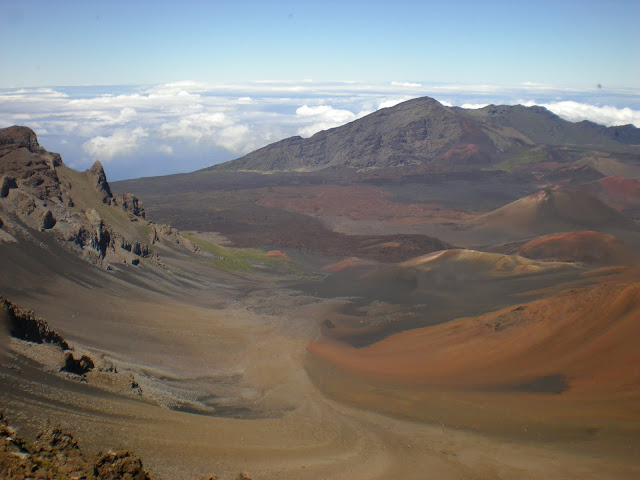Above the cloud line on Haleakala.
Haleakala was considered sacred by native Hawaiians. The mountain was used for religious purposes, and translated from Hawaiian, Haleakala actually means "House of the Sun." It was believed the sun god lived atop this volcano (which rises 10,023 feet above sea level-- and enormously steep and sudden change in elevation considering it begins just off the coast and shoots up with no gradual incline) and used this vantage point to determine the length of the day.
Looking down on Maui
Because Hawaii is the most isolated spot in the world, it has developed an extremely unique environment over the years-- where plants and animals that made it to the island have evolved separately on the island. Over 25% of the plant and animal species found here are endemic (meaning they are found NOWHERE else in the world and ONLY exist in Hawaii). However, a side effect and downside of the uniqueness of the Hawaiian ecosystem is that it is also an extremely sensitive ecosystem because of its uniqueness. Hawaii has more endangered species than anywhere else in the United States (and possibly in the world). In fact, Hawaii composes 2% of the United States land, but endemic Hawaiian animals make up 60-70% of the endangered species list. Pretty mind blowing. More than 70% of the endemic birds are already extinct. Throughout the years, thousands and thousands of plants and animals have been introduced to Hawaii (though there are still no snakes on the island!), starting with the Polynesians in 500 AD who brought almost all the plants that people associate with Hawaii today-- like coconut palms and birds of paradise.
So basically what we were doing all day today was training to work as leaders for Pacific Whale Foundation's Volunteer on Vacation Invasive Species Program. Haleakala National Park has one of the few places in Hawaii where you can go and see Hawaii as it used to be, before the onset of civilization and alien species. Though most of the park is colonized by pines and a variety of other introduced plants, at the peak of the volcano, you can still see the original, almost untainted alpine desert, and then at parts, there is still a native shrubland forest. We will be working with volunteers to continue to remove invasive species that spread into these pristine and sensitive habitats.
We started out taking a hike to look at the diversity of the untainted/ tainted ecosystems. The difference was startling.
Eucalyptus Forest
Eucalyptus trees were introduced in the 50's as a potential source of commercial wood (a purpose they are not even well suited for). They out compete native species and due to their strong odors and unique tannins, other plants will not even grow in their proximity.
Interspersed Eucalyptus and Pines
More natural shrub land forest and native fern species
One amazing endemic bird (which we did see today, but which I did not get a photo of) is the Nene. This is the state bird of Hawaii, and is a species evolved from Canadian Geese blown off course thousands of years ago. The geese have lost some of their webbing and have developed more pronounced claws for holding onto porous lava rocks. They forage on berries at high elevation.
Later in the day, we headed to the top of the mountain to view the crater.
Haleakala Crater (where the Mars Rover was tested and where parts of Mission on Mars was filmed)
You can go on a 20 mile hike which takes you through the entire crater. Watching people walk through it looked like specks on the landscape.
Overall, I was just amazed today to learn that THIS is what Hawaii really is-- like almost everyone who comes here, I think of Hawaii as a tropical paradise-- overflowing with Mangoes, Passion fruit, Guava, Papaya, Coconut, with white sand beaches and Palm Trees. However, every single one of these plants are non-native. The real Hawaii is only seen atop Haleakala.
The side of Haleakala we saw was in the rain shadow, and I believe the other side of the mountain is much more lush and vegitative
The bathroom. Seeing the Hawaiian language written on something so commonplace just hit home with me and made me think about what a unique and amazing place I get to live in.
We then spent the remaining afternoon learning what invasive plants to look for, and how to comb the landscape in an orderly fashion with volunteers.
Blake (my boss) showing us one of the plants we should be looking for
Overall, it was such an amazing day. I can't believe how lucky I am that I actually get PAID to climb a volcano and learn about this amazing ecosystem. Tomorrow I am back on the boat, but I cant wait to get back up on the mountain, do some serious hiking, and learn everything I can about this place.














Wow that crater is unbelievable! So jealous of your job!!
ReplyDelete